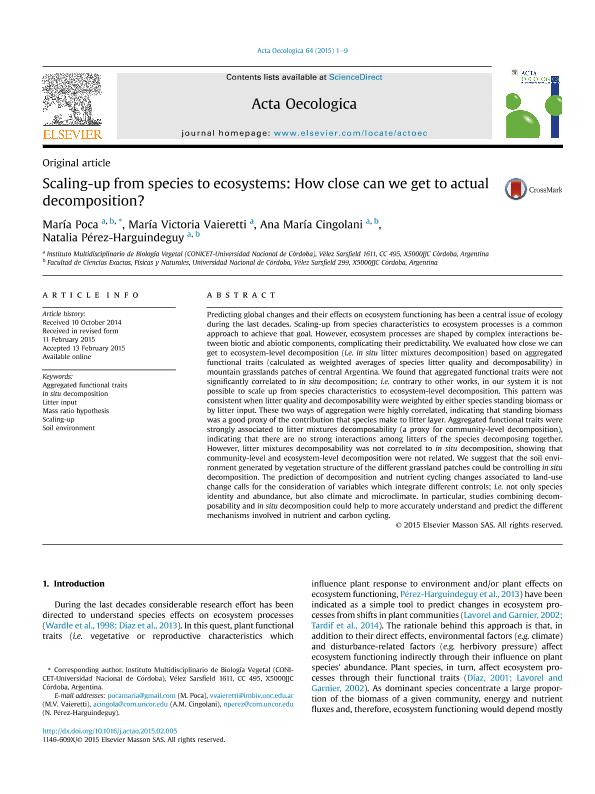Artículo
Scaling-up from species to ecosystems: how close can we get to actual decomposition?
Fecha de publicación:
01/2015
Editorial:
Gauthier-villars/editions Elsevier
Revista:
Acta Oecologica
ISSN:
1146-609X
Idioma:
Inglés
Tipo de recurso:
Artículo publicado
Clasificación temática:
Resumen
Predicting global changes and their effects on ecosystem functioning has been a central issue of ecology during the last decades. Scaling-up from species characteristics to ecosystem processes is a common approach to achieve that goal. However, ecosystem processes are shaped by complex interactions between biotic and abiotic components, complicating their predictability. We evaluated how close we can get to ecosystem-level decomposition (i.e. in situ litter mixtures decomposition) based on aggregated functional traits (calculated as weighted averages of species litter quality and decomposability) in mountain grasslands patches of central Argentina. We found that aggregated functional traits were not significantly correlated to in situ decomposition; i.e. contrary to other works, in our system it is not possible to scale up from species characteristics to ecosystem-level decomposition. This pattern was consistent when litter quality and decomposability were weighted by either species standing biomass or by litter input. These two ways of aggregation were highly correlated, indicating that standing biomass was a good proxy of the contribution that species make to litter layer. Aggregated functional traits were strongly associated to litter mixtures decomposability (a proxy for community-level decomposition), indicating that there are no strong interactions among litters of the species decomposing together. However, litter mixtures decomposability was not correlated to in situ decomposition, showing that community-level and ecosystem-level decomposition were not related. We suggest that the soil environment generated by vegetation structure of the different grassland patches could be controlling in situ decomposition. The prediction of decomposition and nutrient cycling changes associated to land-use change calls for the consideration of variables which integrate different controls; i.e. not only species identity and abundance, but also climate and microclimate. In particular, studies combining decomposability and in situ decomposition could help to more accurately understand and predict the different mechanisms involved in nutrient and carbon cycling.
Archivos asociados
Licencia
Identificadores
Colecciones
Articulos(IMBIV)
Articulos de INST.MULTIDISCIPL.DE BIOLOGIA VEGETAL (P)
Articulos de INST.MULTIDISCIPL.DE BIOLOGIA VEGETAL (P)
Citación
Poca, María; Vaieretti, Maria Victoria; Cingolani, Ana María; Pérez Harguindeguy, Natalia; Scaling-up from species to ecosystems: how close can we get to actual decomposition?; Gauthier-villars/editions Elsevier; Acta Oecologica; 64; 1-2015; 1-9
Compartir
Altmétricas




